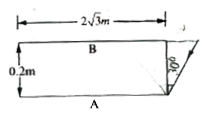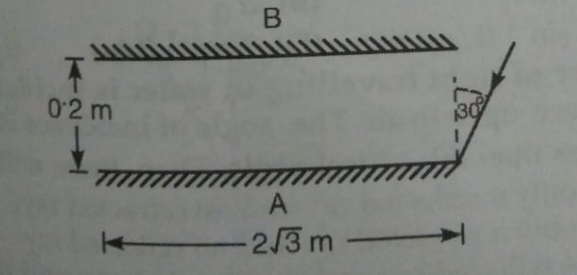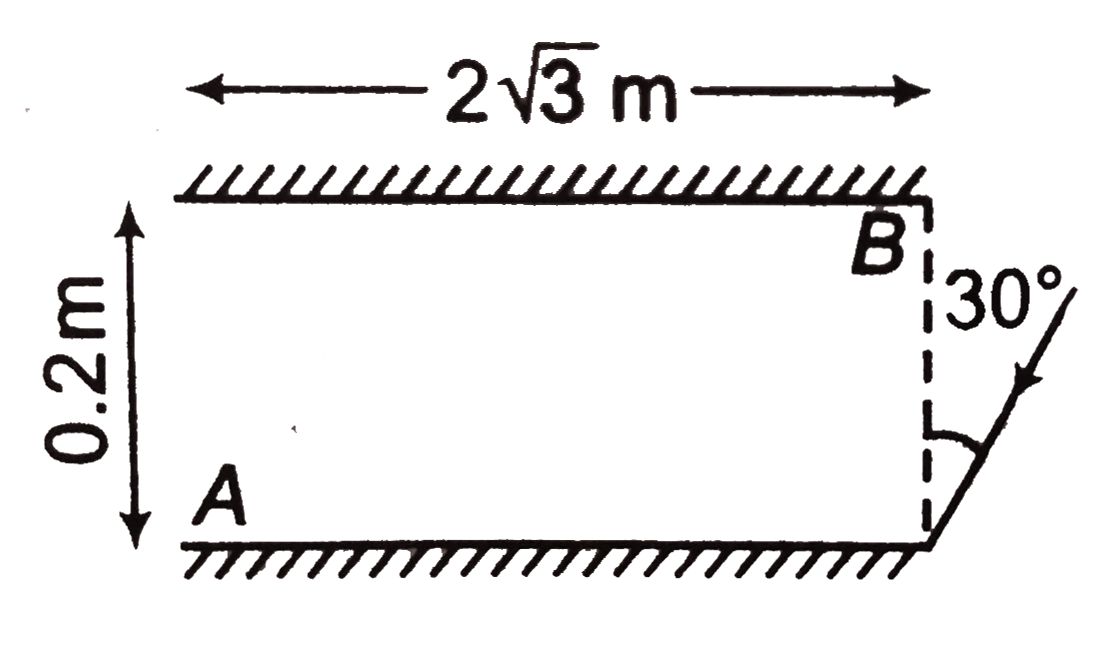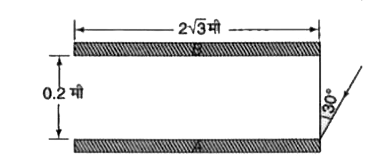Two plane mirrors A and B are aligned parallel to each other as shown in the figure. A light ray is incident at an angle 30° at a point just inside one end of A. The plane of incidence coincides with the plane of the figure. The maximum number of times the ray undergoes reflections including the first one before it emerges out isA 28 B 30 C 32 D 34
Correct option B 30 Explanation:OP is distance covered by the ray in one reflection. Number of times the ray undergoes reflections before it emerges out
Related Solutions
Two plane mirrors A and B are aligned parallel to each other, as shown in figure. A light ray is incident at an angle of at a point just inside one end A. The plane of incidence coincides with the plane of the figure. The maximum number of times the ray undergoes reflections (including the first one) before it emerges out is

View SolutionTwo plane mirrors A and B are aligned parallel to each other, as shown in the figure. A light ray is incident at an angle 30^@ at a point just inside one end of A. The plane of incidence coincides with the plane of the figure. Find the maximum number of times the ray undergoes reflections (including the first one) before it emerges out
View SolutionTwo plane mirrors A and B are aligned parallel to each other, as shown in the figure. A light ray is incident at an angle at a point just inside one end of A. The plane of incidence coincides with the plane of the figure. The maximum number of times the ray undergoes reflections (including the first one) before it emerges out is

View SolutionTwo plane mirros A and B are aligned parallel to each other, as shown in figure. A light ray is incident at an angle of 30^(@) at a point just inside one end of A. The plane of incidence coincides with the plane of the figure. The maximum number of times the ray undergoes reflection (includeing the first one) before it emerges out is
View SolutionTwo plane mirrors A and B are aligned parallel to each other, as shown in the figure. A light ray is incident at an angle of 30^@ at a point just nside one end of A. The plane of incidence coincides with the plane of the figure. The maximum number of times the ray undergoes reflections (including the first one) before it emerges out is)
View SolutionTwo plane mirrors A and B are aligned parallel to each other, as shown in the figure. A light ray is incident at an angle '30degree' at a point just inside one end of A. The plane of incidence coincides with the plane of the figure. The maximum number of times the ray undergoes reflections (including the first one) before it emerges out is
View SolutionTwo plane mirrors A and B are aligned parallel to each other, as shown in the figure. A light ray is incident at an angle 30degree at a point just inside one end of A. The plane of incidence coincides with the plane of the figure. The maximum number of times the ray undergoes reflections (including the first one) before it emerges out is
View SolutionTwo plane mirrors A and B are aligned parallel to each other ,as shown in the figure.A light ray is incident at an angle at a point just inside one end of A.The plane of incidence coincides with the plane of the figure.

The maximum number of times the ray undergors reflections(including the first one,before it emerges out is
View SolutionTwo plane mirrors P and Q are aligned parallel to each other, as shown in the figure. A light ray is incident at an angle of q at a point just inside one end of A. The plane of incidence coincides with the plane of the figure. The maximum number of times the ray undergoes reflections (including the first one) before it emerges out is:

View SolutionTwo plane mirrors A and B are parallel to each other as shown in the figure. at a point just inside one end of a ray of light 30^@ incident at an angle. The angle of incidence coincides with the plane of the figure. What is the maximum number of reflections (including the first) before it emerges out of the ray:
View SolutionTwo plane mirrors A and B are aligned parallel to each other as shown in the figure. A light ray is incident at an angle of at a point just inside one end of A. The number of times the ray undergoes reflections (including the first one) before it emerges out is

View SolutionTwo plane mirrors A and B are aligned parallel to each other as shown in the figure. A light ray is incident at an angle of 30^(@) at a point just inside one end of A. The number of times the ray undergoes reflections (including the first one) before it emerges out is
View Solutionदो समतल दर्पण A तथा B परस्पर समान्तर रखे गए हैं | दर्पण A के एक सिरे के ठीक भीतर स्थित एक बिंदु पर एक प्रकाश किरण के कोण पर चित्रानुसार आपतित है | आपतन तल चित्र के तल के सम्पाती है | प्रकाश किरण दर्पणों के दूसरे सिरे से निर्गत होने से पहले अधिक से अधिक जितनी बार परावर्तित होती है ( प्रथम परावर्तन को सम्मिलित करते हुए ) वह है

View SolutionDraw the incident ray and the reflected ray. if a light ray is incident on a plane mirror with the angle of incidence 30^@ .
View SolutionA ray of light is incident on a plane mirror at an angle of 30°. What is the angle of reflection ?
View SolutionA plane mirror reflecting a ray of incident light is rotated through an angle of about an axis through the point of incidence in the plane of the mirror and perpendicular to the plane of incidence then
View SolutionTwo plane mirrors are at right angles to each other. The angle of incidence of a ray of light. But is incident on one of the mirrors in such a way that the finally reflected ray is parallel to the ray coming after reflection from the other mirror. So is:
View Solutionएक समतल दर्पण पर प्रकाश की किरण कोण पर आपतित हो रही है तो परावर्तित किरण एवं आपतित किरण के मध्य कितना कोण बनेगा ?
View SolutionIf angle fo incidence of a light ray on a plane mirror is , then
View Solutionएक आपतित किरण समतल दर्पण 30° का आपतन कोण बनाती है तो परावर्तन कोण का मान होगा?
View Solution